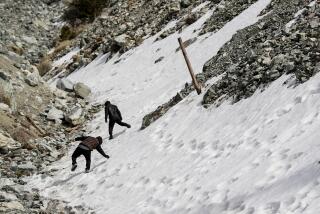Nepal earthquake leaves climbers stranded on Mt. Everest
The earthquake-triggered avalanches that killed and critically injured dozens of climbers on Mt. Everest also destroyed the path between two camps on the side of the world’s tallest mountain, leaving some mountaineers stranded and awaiting rescue.
After the magnitude 7.8 earthquake shook Nepal early Saturday, a wall of rock and debris swept through Everest’s base camp, where more than 1,000 climbers, guides and support staff from dozens of expeditions had gathered in the last few weeks to prepare for the final stage of their climb. A second avalanche, triggered by a magnitude 6.7 aftershock, complicated rescue attempts Sunday, climbers said in social media posts.
The first avalanche left at least 17 climbers dead, according to media reports, which would make it the deadliest disaster in the recorded history of Mt. Everest. The dead included Dan Fredinburg, a Google executive, and Eve Girawong, the base camp medic for one of the expeditions, Madison Mountaineering.
The avalanche also damaged the Khumbu Icefall, a key route up the lower part of the Everest ascent. Groups of climbers at the two camps above the glacier and the ice blocks surrounding it have not tried to return to base camp, climbers said, fearing unstable ground and sudden shifts in the ice, which could cause crevasses to open.
“Horrible here in camp 1,” one British climber tweeted, saying he saw “avalanches on three sides” of the camp. “We worry about ice fall team below … alive?”
The winds that came with the avalanches “completely pulverized and blew the camp away,” American climber Jon Kedrowski wrote in a blog post. He saw duffel bags, boots, tent frames and ice axes flung into the air, and “some people were picked up and tossed across the glacier for a hundred yards.” Many injuries, he wrote, “were similar to ones you might see in the Midwest when a tornado hits, with contusions and lacerations from flying debris.”
The damage at Everest’s base camp is particularly difficult for climbers to come to terms with because the area is known as a safe space, where the weary and injured can recuperate and rest, said Ed Viesturs, a professional mountaineer who has climbed Everest.
“Base camp is the place where you feel completely safe, where you gain strength and relax,” Viesturs said. “Just when you thought you were safely off the mountain, the base camp is decimated and people are dead. You can imagine how shocking that is.”
Some areas of the base camp looked like they had been hit by a “nuclear blast,” one mountaineer wrote on Twitter. “Great desolation. High uncertainty.”
Helicopters evacuated the most critically injured climbers after the avalanche, representatives from mountaineering companies said, most of them Sherpas or guides who were working at the base camp. Some climbers were brought down from Camp 1 early Monday morning.
Still, the majority of climbers will probably stay in the two higher camps for several days. Mountaineering company representatives said their climbers had enough food, fuel and gear for them to survive for several days without any cause for concern.
A group of eight climbers from Colorado was trapped at the higher of the two camps above the Khumbu Icefall, according to an online audio recording from mountaineer Alan Arnette, with the Madison Mountaineering group. He said the group was slowly making its way down to the lower camp, where the climbers hoped to find a helicopter to carry them down.
“They’re effectively trapped up there until somebody can organize the fixing of the ropes and the ladders that go through the ice fall,” Viesturs said. “You can imagine, though, that there’s some shell shock. The people higher on the mountain, they’re feeling a little isolated, and slightly trapped.”
Helicopter rescues at high elevations can be dangerous, Viesturs said, made more complicated by the perilous angles of the peaks and the thin air.
“The air is so thin that it’s difficult for them to get lift,” Viesturs said. In the 1990s, he said, helicopter pilots often removed everything from the vehicles, including the doors, to make them as light as possible. “Then you have to throw a 200-pound person inside, and create lift — that’s really, really difficult.”
Gordon Janow, the director of programs at Seattle-based Alpine Ascents International, said the organization’s expedition of more than a dozen climbers, Sherpas and support staff was waiting to be evacuated from the camp directly above the Khumbu Icefall.
“Because of the tremors, the blocks of ice are settling differently each day, so you can’t set up a route or a ladder system up there,” Janow said. He added that the climbers were in good spirits, and that their situation was “overshadowed by the condition at base camp — the deaths, the injuries and the people who need medical attention.”
In some ways, climbers in the higher camps were lucky to be stranded, experts said. They missed the decimation of base camp, and the emotional trauma of watching fellow climbers lose their lives.
But “when they return, they will have nothing, they will be homeless and their camp is destroyed,” Kedrowski wrote. “Many other teams will have to accept the same fate, but they were lucky, and so were we.”
More to Read
Start your day right
Sign up for Essential California for news, features and recommendations from the L.A. Times and beyond in your inbox six days a week.
You may occasionally receive promotional content from the Los Angeles Times.







